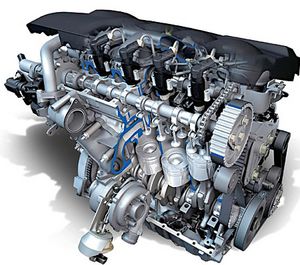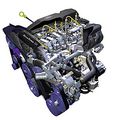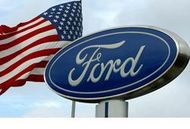.
Ford Duratorq engine

| |
| Ford Duratorq | |
|---|---|
| Engine | |
| Manufacturer | Ford |
| aka | Type aka here, not up there |
| Type | Note what type of fuel it consumes |
| Production/Introduction | produced/introduced from when to when |
| Status | Note if it is "In Production", "In Development", a "Concept Only", "Stillborn" or "Discontinued" |
| Displacement | in litres, cc's or cu-in. |
| Aspiration | write its type of aspiration |
| Configuration | write the configuration of the cylinders |
| Cylinders | write the number of cylinders present |
| Fuel System | write if it is injected or carburated and the system used |
| Lubrification | indicate the engine's type of lubrification |
| Output | N/A hp @ N/A rpm N/A lb-ft. of torque @ N/A rpm |
| Bore | in inches |
| Stroke | in inches |
| Compression | write compression ratio here |
| In. Valves | in inches |
| Ex. Valves | in inches |
| Firing Order | Firing order of cylinders |
| Left Bank | Write which cylinders are in this bank (write N/A if it it is inline) |
| Right Bank | (same as above) |
| Length | in inches |
| Diameter | in inches |
| Width | in inches |
| Height | in inches |
| Dry Weight | lbs. / kg. |
| Fuel Consumption | city/highway (mpg & km/L) |
| Emission/s | CO: g/km CO2: g/km NOx: g/km Hydrocarbon: g/km Particulate: g/km |
| Chief Engineer | write here |
The Ford Duratorq engine, commonly referred to as Duratorq, is the marketing name of a range of Ford diesel engines first introduced in 2000 for the Ford Mondeo range of cars.
The first design, codenamed "Puma" during its development replaced the older Endura-D unit which had been around since 1984. Commercial versions of the Puma unit replaced Ford's older "York" type unit used in the Transit, and many other manufacturers' vehicles - most notably the London Taxi.
Other, unrelated units in this range have been developed in conjunction with Peugeot. These engines are therefore available in Ford, Peugeot, Citroën, Jaguar, Land Rover, Volvo and Mazda vehicles. They are given different names by PSA Peugeot Citroën (PSA).
DLD ("Lynx")
- Main article: Ford DLD engine
The straight-4 engines are sold under the Duratorq TDCi name by Ford, and as the HDi by Citroën and Peugeot. These are part of the DLD family. Mazda also uses the DLD engine in the Mazda2 and the Mazda3, calling it the MZ-CD or CiTD. The Ford/PSA joint-venture for the production of the DLD was announced in September, 1998.
Officially, there are two families of engines in the range:
- The 1.4L is generally non-intercooled
- The 1.6 L always intercooled
Ford later added their unrelated 1.8 L DLD-418 engine to the DLD family, though it is properly part of the Ford Endura engine family.
1.4
The Duratorq DLD-414 (or DV4) is a 1.4 L (1399 cc/85 in³) straight-4 turbo-Diesel. Output is 50 kW (67 hp) at 4500 rpm and 160 N·m (117 ft·lbf) at 2000 rpm.
The DV4 is available in two versions:
- One, an 8-valve design, uses a Borg-Warner KP35 turbocharger but no intercooler. This is the same turbocharger as the Renault K9K Diesel. It is Euro III compliant, but will receive a diesel particulate filter in 2006 to make it Euro IV compliant. It also uses [[1]]'s DCR1400 common-rail injection system.
- A second version uses a DOHC 16-valve design, with an intercooled variable geometry turbocharger. This derivation will no longer be built from 2006, as it will not be able to comply with the Euro IV regulations.
1.6
The DLD-416 (or DV6) is a 1.6 L (1560 cc/95 in³) 90hp or 110hp version also used by Ford, Mazda and PSA.
1.8
The Duratorq DLD-418 is a 1.8 L (1753 cc) intercooled common rail diesel engine. It is completely unrelated to the 1.4/1.6 units, and is a development of Ford's 1.8 8v Endura-D engine that saw service through the 1980s and 1990s. However, Ford considers it part of the DLD family, as evidenced by the official "DLD" name.
The Endura-D was heavily revised and updated with a variable-vane turbocharger and a Delphi high-pressure common rail injection system and relaunched in 2001 as the 'DuraTorq TDCi', with the original engine being rebadged 'DuraTorq TDDi'.
ZSD ("Puma")
Codenamed Puma during development, these Ford 2.0 L, 2.2 L, and 2.4 L engines are called ZSD. They are produced at the company's Dagenham plant in East London.
2.0
Released in 2000, to coincide with the launch of the Mk3 Ford Mondeo, the Duratorq ZSD-420 was initially available as a 2.0L (1998 cc) direct injection turbodiesel. Producing 115 PS (113hp/85kW) and 280Nm (207ft·lbf) it was a vast improvement over the 1.8 Endura-D powering the Mk2 Mondeo. It featured a 16-valve cylinder head with twin chain driven camshafts and utilised a variable geometry turbocharger with overboost function.
In late 2001 the engine was fitted with Delphi common rail fuel injection and called the Duratorq TDCi (Turbo Diesel Commonrail injection), with the original unit being renamed the Duratorq TDDi (Turbo Diesel Direct injection). Although generally identical to the original engine, the addition of the common rail system meant power was increased to 130PS 128hp/95kW), with torque rising to 330Nm (244ft·lbf). In 2002 the Duratorq TDDi was replaced by a detuned version of the Duratorq TDCi. Producing 115PS and 285Nm, this unit used a fixed geometry turbocharger in place of the variable geometry unit used in the TDDi and 130PS TDCi.
With 2005 came another detuned version of the TDCi for the Mondeo. Producing 90PS (89hp/66kW) and 280Nm (207ft·lbf), this engine was substantially cheaper than other versions and was mainly targeted at fleet buyers.
Applications:
- 2000–2002 Ford Mondeo 2.0 TD & TDDi, 115PS (113hp/85kW) and 207ft·lbf (280N·m)
- 2001–2007 Ford Mondeo 2.0 TDCi 130, 130PS (128hp/95kW) and 244ft·lbf (330N·m)
- 2002–2007 Ford Mondeo 2.0 TDCi 115, 115PS (113hp/85kW) and 210ft·lbf (285N·m)
- 2005–2007 Ford Mondeo 2.0 TDCi 90, 90PS (89hp/66kW) and 181ft·lbf (245N·m)
- 2003–Present Jaguar X-Type 2.0d, 130PS (128hp/95kW) and 244ft·lbf (330N·m)
2.2
In 2005, Ford introduced the Duratorq ZSD-422, a 2.2 L (2184 cc) turbodiesel for top-of-the-range versions of the Mondeo and Jaguar X-Type which produced 155PS (153hp/114kW). This is unrelated to the PSA DW12 2.2 unit used in Peugeot and Citroën applications.
Applications:
- 2005–2007Ford Mondeo 2.2 TDCi 155, 155PS (153hp/114kW) and 262ft·lbf (355N·m)
- 2005–Present Jaguar X-Type 2.2d, 155PS (153hp/114kW) and 262ft·lbf (355N·m)
2.4
The 2.4 L (2402 cc) Duratorq ZSD-424 is a turbocharged and intercooled Diesel. Output is 55 to 101 kW (74 to 135 hp) and 185 to 285 N·m (136 to 210 ft·lbf).
Applications:
- Ford Transit
- 2002 London Taxi TXII
- 2007-onward Land Rover Defender
2.5
Ford introduced a new 2.5 L version of the Duratorq for the Thailand-built 2007 Ford Ranger (J97U). It is a 16-valve DOHC engine of the VM Motori 2500 cc engine, with Bosch common-rail direct injection and a variable geometry turbocharger. It produces 143 PS (141 hp/105 kW) and 330 N·m (243 ft·lbf).<ref>ALL NEW FORD RANGER MAKES WORLD DEBUT IN THAILAND Ford press release, March 7, 2006</ref>
3.0
A 3.0 L Duratorq similar to the 2.5 is also used in the 2007 Ranger as the top of the range. It produces 156 PS (154 hp/115 kW) and 380 N·m (280 ft·lbf).
2005 TDCi (PSA DW Based)
Continuing the Ford/PSA diesel engine joint-venture, these straight-4 engines are again sold under the Duratorq TDCi name by Ford, and as the HDi by Citroën and Peugeot. An evolution of the existing DW10/DW12 engine, the new engines have a traditional belt-driven system, moving away from the chain-driven camshafts of the previous generation (Puma) TDCi engines. Both engines utilise the latest advances in diesel technology by combining power, refinement and excellent fuel economy and are the result of the fourth phase of the cooperation between PSA and Ford (initiated in 1998).
Both engines utilise an all-new, third-generation Bosch common rail injection system in which the injection pressure has been increased to 1800 bar. This higher injection pressure, associated with new piezo-electric injectors in which each nozzle is equipped with seven apertures (instead of five previously) with a diameter of 135 microns, allows the number of injections to be multiplied (potentially up to six per cycle) and ensures meticulous uniformity of the diesel injection spray pattern. As a result of this optimised air/diesel mix, combustion is more complete and more uniform, and therefore reduces emissions at source.
2.0
Based on the PSA DW10 engine and with a capacity of 1997cc, this engine was released in the 2005 Ford Focus, and followed in the 2007 Mk IV Mondeo. It features a 16-valve cylinder head with twin belt driven camshafts and utilises a variable geometry turbocharger with overboost function.
In the 2005 Focus, output is a respectable 136 PS (134 hp/100 kW). In the 2007 Mondeo it is offered with 130 PS (128 hp/96 kW) or 140 PS (138 hp/103 kW), mated to a manual or 6-speed Durashift automatic gearbox.
Applications:
- 2005–present Ford Focus 2.0 TDCi, 136 PS (134 hp/100 kW) and 251 ft·lbf (340 N·m)
- 2006–present Ford S-Max 2.0 TDCi, 130 PS (128 hp/96 kW) and 251 ft·lbf (340 N·m)
- 2006–present Ford S-Max 2.0 TDCi, 140 PS (138 hp/103 kW) and 251 ft·lbf (340 N·m)
- 2006–present Ford Galaxy 2.0 TDCi, 130 PS (128 hp/96 kW) and 251 ft·lbf (340 N·m)
- 2006–present Ford Galaxy 2.0 TDCi, 140 PS (138 hp/103 kW) and 251 ft·lbf (340 N·m)
- 2007–present Ford Mondeo 2.0 TDCi, 130 PS (128 hp/96 kW) and 251 ft·lbf (340 N·m)
- 2007–present Ford Mondeo 2.0 TDCi, 140 PS (138 hp/103 kW) and 251 ft·lbf (340 N·m)
Other Applications:
- 2005–2007 Peugeot 307 2.0 HDi, 136 PS (134 hp/100 kW) and 251 ft·lbf (340 N·m)
- 2005–present Peugeot 407 2.0 HDi, 136 PS (134 hp/100 kW) and 251 ft·lbf (340 N·m)
- 2005–present Peugeot 607 2.0 HDi, 136 PS (134 hp/100 kW) and 251 ft·lbf (340 N·m)
- 2006–present Peugeot 807 2.0 HDi, 136 PS (134 hp/100 kW) and 251 ft·lbf (340 N·m)
- 2008–present Peugeot 308 2.0 HDi, 136 PS (134 hp/100 kW) and 251 ft·lbf (340 N·m)
2.2
Based on the PSA DW12 engine and with a capacity of 2179cc, this engine was released in April 2008 by Ford in the Mk IV Mondeo, soon following in the Ford S-Max and Ford Galaxy. It features a 16-valve cylinder head with twin belt driven camshafts and utilises a variable geometry turbocharger with overboost function, rather than the twin turbo approach of Peugeot and Citroen. The result is a very respectable 175 PS (172 hp/129 kW) complete with 295 ft·lbf (400 N·m) of torque, although 310 ft·lbf (420 N·m) is temporarily available thanks to the transient overboost function.
Applications:
- 2008–present Ford Mondeo 2.2 TDCi, 175 PS (172 hp/129 kW) and 295 ft·lbf (400 N·m)
- 2008–present Ford S-Max 2.2 TDCi, 175 PS (172 hp/129 kW) and 295 ft·lbf (400 N·m)
- 2008–present Ford Galaxy 2.2 TDCi, 175 PS (172 hp/129 kW) and 295 ft·lbf (400 N·m)
Other Applications:
- 2006–present Land Rover Freelander 2.2 Td4, 160 PS (157 hp/117 kW) and 295 ft·lbf (400 N·m)
- 2006–present Citroen C5 2.2 HDi, 172 PS (170 hp/126 kW) and 277 ft·lbf (370 N·m)
- 2006–present Citroen C6 2.2 HDi, 172 PS (170 hp/126 kW) and 277 ft·lbf (370 N·m)
- 2006–present Citroen C8 2.2 HDi, 172 PS (170 hp/126 kW) and 277 ft·lbf (370 N·m)
- 2007–present Peugeot 407 2.2 HDi, 172 PS (170 hp/126 kW) and 277 ft·lbf (370 N·m)
- 2007–present Peugeot 607 2.2 HDi, 172 PS (170 hp/126 kW) and 277 ft·lbf (370 N·m)
- 2007–present Peugeot 807 2.2 HDi, 172 PS (170 hp/126 kW) and 277 ft·lbf (370 N·m)
V6
AJD-V6/DT17
The 2.7 L (2720 cc) V6 is built by Ford and Jaguar Cars at their Dagenham facility, and was designed by Ford engineers at their Dunton and Whitley product development centres. It is called AJD-V6 by Jaguar and DT17 by PSA Peugeot Citroën.
Ford and PSA extended their Diesel engine joint-venture in October, 1999, to include this V6 engine.
Applications:
- 2006–present Citroën C6 2.7 V6 HDi, 204 PS (201 hp/150 kW) and 325 ft·lbf (440 N·m)
- 2008–present Citroën C5 2.7 V6 HDi, 204 PS (201 hp/150 kW) and 325 ft·lbf (440 N·m)
- 2004–2008 Jaguar S-Type 2.7 DV6, 204 PS (201 hp/150 kW) and 325 ft·lbf (440 N·m)
- 2005–present Jaguar XJ TDVi 2.7, 204 PS (201 hp/150 kW) and 325 ft·lbf (440 N·m)
- 2008–present Jaguar XF 2.7D, 204 PS (201 hp/150 kW) and 325 ft·lbf (440 N·m)
- 2005–present Land Rover Discovery Td6, 190 PS (187 hp/140 kW) and 325 ft·lbf (440 N·m)
- 2006–present Land Rover Range Rover Sport Td6, 204 PS (201 hp/150 kW) and 325 ft·lbf (440 N·m)
- 2005–present Peugeot 407 Coupé 2.7 V6 HDi, 204 PS (201 hp/150 kW) and 325 ft·lbf (440 N·m)
- 2005–present Peugeot 607 2.7 V6 HDi, 204 PS (201 hp/150 kW) and 325 ft·lbf (440 N·m)
V8
AJD-V8
The 3.6 L V8 is built at Dagenham engine, It is a twin-turbocharged Diesel V8 producing 270 PS (266 hp/199 kW) and 640 N·m (472 ft·lbf). Production began in April 2006. It is very closely related to the 2.7L version (same bore & stroke) and was designed at Ford's Dagenham Diesel Centre product development site, with input from Land Rover powertrain team.
Applications:
Photos
See also
| Ford cars made for the European market | ||
| Köln | Y | Rheinland | Eifel | C Ten | 7Y | 7W | Prefect | Anglia | Pilot | Zephyr | Consul | Squire | Taunus Vedette | Comète | Cortina | Popular | Classic | Corsair | Escort | Capri | Granada | Fiesta | Sierra | RS200 | Orion | Scorpio | Probe | Mondeo | Galaxy | Ka | Puma | Focus | Cougar | Maverick | Fusion | GT | Focus C-MAX | S-MAX | ||
| Edit this template | ||
References
| references-column-width
| references-column-count references-column-count-{{{1}}} }}
| {{#if:
| references-column-width }} }}" style="{{#if:
| {{#iferror: {{#ifexpr: 1 > 1 }}
| column-width: {{{1}}}; -moz-column-width: {{{1}}}; -webkit-column-width: {{{1}}};
| column-count: {{{1}}}; -moz-column-count: {{{1}}}; -webkit-column-count: {{{1}}}; }}
| {{#if:
| column-width: {{{colwidth}}}; -moz-column-width: {{{colwidth}}}; -webkit-column-width: {{{colwidth}}}; }} }}">
<references group=""></references>- Template:Citation/core{{#if:January 32006|}}



